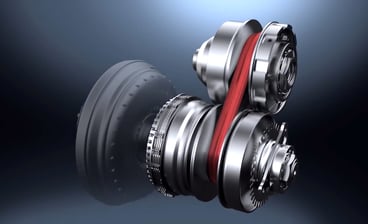CVT Global Industry Production Outlook [IHS Data]
 Among the debates on how many gears a vehicle needs in 2018, one emerging transmission innovation adds an interesting angle to the conversation. The CVT (continuously variable transmission) is a technology that eliminates the need for a set number of gears, designed instead to shift using infinite gear ratios. Today, CVT transmissions are more well-developed than ever, and manufacturers are starting to understand how to incorporate them into their vehicles. But what kind of market share do CVTs really have, and how can we expect them to impact the transmission industry moving forward? In this blog post, we'll take a look at IHS data that illustrates what CVT industry production looks like today and in the future.
Among the debates on how many gears a vehicle needs in 2018, one emerging transmission innovation adds an interesting angle to the conversation. The CVT (continuously variable transmission) is a technology that eliminates the need for a set number of gears, designed instead to shift using infinite gear ratios. Today, CVT transmissions are more well-developed than ever, and manufacturers are starting to understand how to incorporate them into their vehicles. But what kind of market share do CVTs really have, and how can we expect them to impact the transmission industry moving forward? In this blog post, we'll take a look at IHS data that illustrates what CVT industry production looks like today and in the future.
CVT Industry Production Numbers
According to IHS Markit data, global production of all CVTs (light duty transmission, gasoline) has reached 13.6 million in 2018. This number is expected to increase to over 14M by 2019, then grow to over 15M by 2020 and stay relatively steady through 2025. In comparison, production is expected to decrease over the same period for automatic transmissions that have six or fewer forward speeds. However, automatic transmissions with seven or more forward speeds are projected to grow in production from 2018, implying a trend toward transmissions with more gears in general.
 In terms of market share, CVTs have carved out a significant portion in recent years. From 2005-2015, IHS Markit data shows, CVT market share increased from less than 5% to 12% of the global transmission market. CVT development relies on the input of a wide range of key players, including manufacturers like JATCO, Aisin AW, Bosch, Honda, Toyota, Fuji Heavy Industries, and others. The CVT's ability to keep the engine at its most efficient operating range by way of its infinite number of ratios, as opposed to traditional manual or automatic transmissions, are the defining features allowing CVTs to break into the transmission market as a disrupting force.
In terms of market share, CVTs have carved out a significant portion in recent years. From 2005-2015, IHS Markit data shows, CVT market share increased from less than 5% to 12% of the global transmission market. CVT development relies on the input of a wide range of key players, including manufacturers like JATCO, Aisin AW, Bosch, Honda, Toyota, Fuji Heavy Industries, and others. The CVT's ability to keep the engine at its most efficient operating range by way of its infinite number of ratios, as opposed to traditional manual or automatic transmissions, are the defining features allowing CVTs to break into the transmission market as a disrupting force.
The Future of CVTs and the Transmission Market
As new transmission technologies continue to emerge in the coming years, IHS Markit data predicts that by the year 2025, manual and automatic transmissions will comprise only 65% of the transmission market, dropping significantly from the 95% share these types dominated in 2005. On the other hand, in less than a decade, the emerging transmission technologies of today will have a much larger presence in the market. Most notably, CVTs will reach around 13% by 2025, while DCTs will increase to 14%. Other transmission types will also experience slight increases in market share. What all this data goes to show is that in the long run, global production is certainly trending toward transmissions with more speeds (and in the case of CVTs, unlimited speeds) in the coming years, and that transition to new technology may be coming sooner than you expected.


